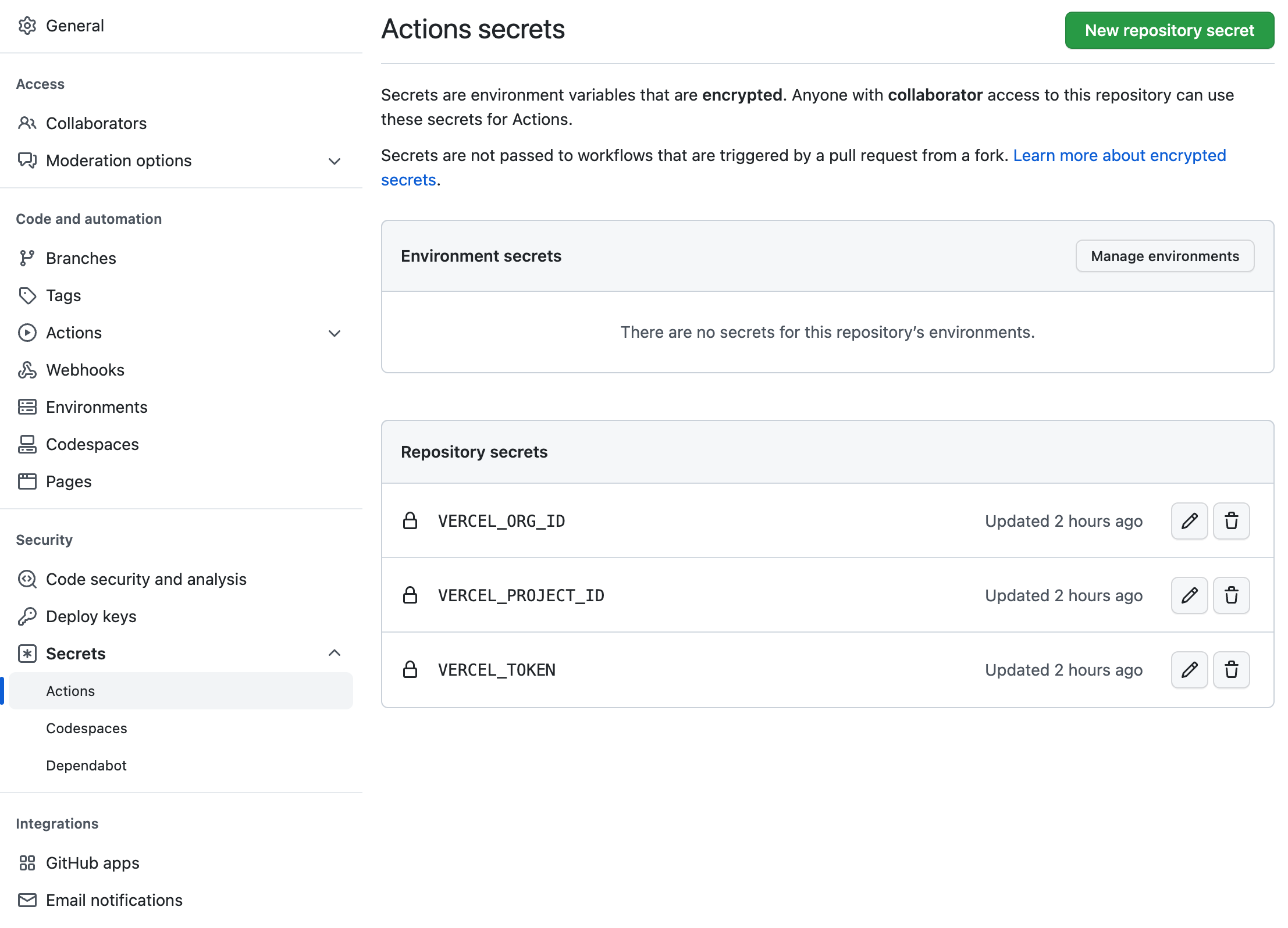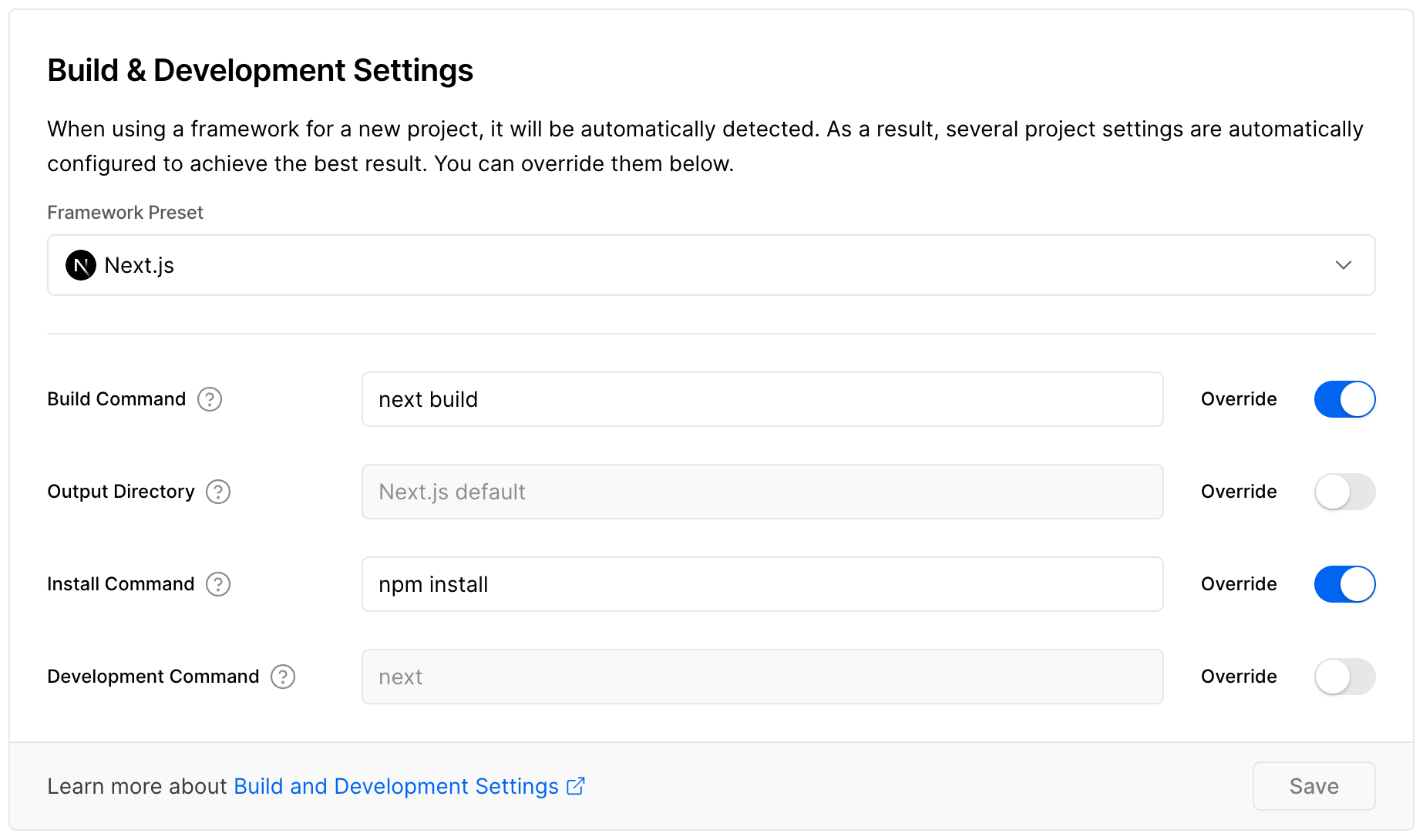#Overview
Vercel (formerly known as Zeit prior to 2020) is designed for simple deployments of Next.js applications (or other frontend applications).
For a certain project, we had started deploying to Vercel to gain use from its simple setup and user experience, but our team also wanted to use GitHub Actions to build and run our tests. Following this guide on Vercel, we figured it would be easy to disconnect Vercel's GitHub connection and strictly use the CLI to deploy through Actions. After some time of fighting, we were able to configure it how we wanted, but the fidgeting took longer than I thought it would, so I figured I'd share...
#Codebase
This post assumes you already have an initialized Next.js application; this specific example will have the project
at the root of the repository (and not within /app). The example I used also has tests that can be run with npm test.
To see this repository, it's on GitHub here.
#Configure workflow
First, here is the GitHub action workflow that we used:
This configuration includes jobs for building, testing, and deploying the application
name: Deploy to Vercel
env:
VERCEL_ORG_ID: ${{ secrets.VERCEL_ORG_ID }}
VERCEL_PROJECT_ID: ${{ secrets.VERCEL_PROJECT_ID }}
on:
push:
branches:
- main
jobs:
build:
runs-on: ubuntu-latest
steps:
- uses: actions/checkout@v3
- name: Use Node.js
uses: actions/setup-node@v3
- run: npm ci
- run: npm run build --if-present
test:
needs: build
runs-on: ubuntu-latest
steps:
- uses: actions/checkout@v3
- name: Use Node.js
uses: actions/setup-node@v3
- run: npm ci
- run: npm run test:ci
deploy:
needs: [build, test]
runs-on: ubuntu-latest
steps:
- uses: actions/checkout@v3
- name: Install Vercel CLI
run: npm install --global vercel@latest
- name: Pull Vercel Environment Information
run: vercel pull --yes --environment=production --token=${{ secrets.VERCEL_TOKEN }}
- name: Build Project Artifacts
run: vercel build --prod --token=${{ secrets.VERCEL_TOKEN }}
- name: Deploy Project Artifacts to Vercel
run: vercel --prebuilt --prod --token=${{ secrets.VERCEL_TOKEN }}The primary code of importance here is the final deploy job, which comes almost directly off the guide
Vercel wrote. If you need more help, GitHub Actions documentation is quite thorough.
These steps under the deploy job are pretty straightforward, it
- checks out the repository
- pulls the Vercel environment info
- builds the Next.js application (using the aforementioned env info)
- deploys the built application to vercel production environment
The only thing worth noting here is that the --prebuilt parameter is only needed when the vercel build command is being used prior to the deploy.
It is possible to build the application during the vercel deploy in which the parameter would not be needed. We found it easier to read
and debug in our example if we had them as two different steps.
#Secrets
First, you must find all three tokens/secrets/IDs Vercel requires to authenticate and deploy.
VERCEL_TOKEN
- On Vercel, go to User Profile > Settings > Tokens (Create new token)
VERCEL_PROJECT_ID
- On Vercel, go to Project > Settings > Overview > Project ID
VERCEL_ORG_ID
- Install Vercel CLI on machine
vercel loginto authenticate machine with Vercel- At the root of your project, run
vercel linkwhich will link local directory to Vercel .vercel/project.jsonwill contain both your projectId and orgId
Secondly, you need to configure the GitHub secrets that the pipeline uses by going to Repository > Settings > Secrets > Actions and creating new repository secrets

#Vercel Configuration
One problem we faced was that we were unable to get the pipeline to retrieve the correct buildCommand and installCommand
(just retrieving null) when our workflow ran.
{
"projectId": "***",
"orgId": "***",
"settings": {
"createdAt": "***",
"framework": null,
"devCommand": null,
"installCommand": null,
"buildCommand": null,
"outputDirectory": null,
"rootDirectory": null,
"directoryListing": false,
"nodeVersion": "18.x"
}
}Vercel doesn't offer an obvious warning that your application isn't being deployed nor even being built,
so it would keep deploying to a 404 without any errors or warnings.
One way of verifying that these commands are configured correctly is to pull the Vercel "configuration" using the CLI and by deploying
locally from the command line.
vercel pull --yes --environment=production --token=${{ secrets.VERCEL_TOKEN }}Another way of verifying the configuration (on the GitHub Action too) is to include the following yaml lines in your workflow. Most of our problems arose from missing Vercel Next.js commands when pulling from our project and printing out the returned values made it easier to debug.
- name: Print out Vercel config
run: pwd && ls -la && cat .vercel/.env.production.local && cat .vercel/project.jsonIf this is a problem, inside the Vercel project settings, you can override the Build & Development Settings with the following:

while leaving the Output Directory and Development Command on default.
This should then return the following configuration allowing you to deploy to Vercel using the GitHub Action (or locally)
{
"projectId": "***",
"orgId": "***",
"settings": {
"createdAt": "***",
"framework": "nextjs",
"devCommand": null,
"installCommand": "npm install",
"buildCommand": "next build",
"outputDirectory": null,
"rootDirectory": null,
"directoryListing": false,
"nodeVersion": "18.x"
}
}#Deployed 🎉
Now, whenever a commit is made on the main branch, GitHub actions will build, test, and deploy to Vercel. This is useful for building more complicated
pipelines that can do anything you want as well as abstracting the deployment details away from Vercel for future
(easily swappable with other products like Netlify).